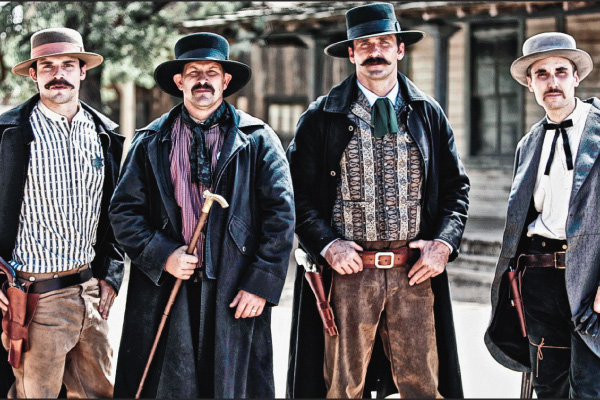 In the “Wyatt Earp: The Tombstone Vendetta” episode of Gunslingers, a weathered Kurt Russell states, “The O.K. Corral is the greatest gunslinger moment of all time.”
In the “Wyatt Earp: The Tombstone Vendetta” episode of Gunslingers, a weathered Kurt Russell states, “The O.K. Corral is the greatest gunslinger moment of all time.”
Like the other on-camera commentators in the show, the actor knows of where he speaks. His performance as the lawman in Tombstone is considered the signature Wyatt Earp of modern Westerns, and his passion for the real man, and his history, is very much on display in this interview.
In fact, a passion for history and its accurate re-creation is at the heart of this new historical docudrama series that debuted in July on the American Heroes Channel. The series tells the stories, warts and all, of the Old West’s famed gunfighters, and their battles, but with a genuinely different dramatic approach that separates Gunslingers from other documentaries on the West and its outlaws.
Gunslingers uses a first-person point of view, with voice-over narration that goes into the motives and darker moments of the men who became Western legends, bringing a new perspective to even the most oft-told stories. This device has its risks, but the rewards are greater.
“Wyatt Earp: The Tombstone Vendetta,” the first episode, sets a fine standard, by dramatizing Earp’s perspective of the events that led up to October 26, 1881. The actor who supplies Earp’s voice sounds too young, especially in contrast to Russell, whose interview is a major part of this episode, but the narration works well with the views offered by Earp experts.
Besides Russell, Tombstone re-enactor Jay Clark, playwright Craig Oldfather, our own executive editor Bob Boze Bell, Tombstone Epitaph contributor Drew Gomber and Wyatt Earp biographer Casey Tefertiller discuss the reputation of the Earp boys, the famous shoot-out and the vendetta that followed.
Paul Hutton, the distinguished professor of history at the University of New Mexico, shares the impact of Stuart N. Lake’s famous biography of Earp, Wyatt Earp: Frontier Marshal, which became Hollywood’s favorite, and distorted, version of the O.K. Corral conflict, as well as the basis for a number of films, including John Ford’s 1946 classic, My Darling Clementine.
All these varied voices give viewers the chance to form their own opinions about the famous lawman. Even more, Gunslingers raises the bar in its re-creations. We’ve seen these done many times before, usually in clumsily staged, badly shot vignettes, with dinner theatre locals playing historical figures—these can be the kiss of death for a documentary.
Yet series director Christopher Cassel wisely took a cinematic approach to these scenes, spending time on coverage and staging. The re-creations have a big look, and they feature well-chosen faces for the Earps and Clantons. In his expert shoots of these scenes, Tim Metzger shows off his fine ability with night photography.
The next episode, “Billy the Kid: The Phantom of Lincoln County,” traces William Bonney’s childhood, exploring his true birthplace, and then segues into his life as Billy the Kid—his involvement in the Lincoln County War, his rides with the Regulators and, ultimately, his death at the hands of Sheriff Pat Garrett.
The narration feels too formal; it lacks the intimacy of conversation provided in the Earp narration. However, if the Earp narrator’s voice felt too young for the lawman, the actor here is absolutely age appropriate for the Kid.
Drama explodes in the portrayals of famous moments in the Kid’s life, including his killing of “Windy” Cahill, his escape from Garrett’s jail and his final moments before being shot dead.
Nonfiction author Mark Lee Gardner and historians and writers Hutton, Bell, Kirk Ellis, Johnny D. Boggs and Will Courtney are among those providing commentary, with each one superbly examining the myths and truths of the young gunslinger who inspired “more than a thousand books and 60 movies.”
The show ends with dramatic flair when the Kid is buried in a grave that is surrounded by a cage, to keep vandals out and, just maybe, keep the Kid in. This haunting image lingers long after the episode’s end, highlighting the filmmaking abilities of Cassel and company.
August brings examinations of the deadly lives and careers of “Jesse James: The South’s Last Rebel,” with insights from The Assassination of Jesse James by the Coward Robert Ford author Ron Hansen, “Wild Bill Hickok: Marksman…and Marked Man,” with Deadwood creator David Milch, “John Wesley Hardin: The Dark Heart of Texas” and concludes with “Tom Horn: Grim Reaper of the Rockies.”
Gunslingers reveals a new path down timeworn trails, thanks to fine direction and first-rate research. The stories will not be unfamiliar to many True West readers, but the series offers you the chance to see some of the Old West’s heroes and villains in a new light—the first-person perspective of the men behind the guns.
C. Courtney Joyner is a screenwriter and director with more than 25 produced movies to his credit. He is the author of The Westerners: Interviews with Actors, Directors and Writers.
Photo Gallery
– Courtesy American Heroes Channel –
– Tombstone photo Courtesy Buena Vista Pictures –







